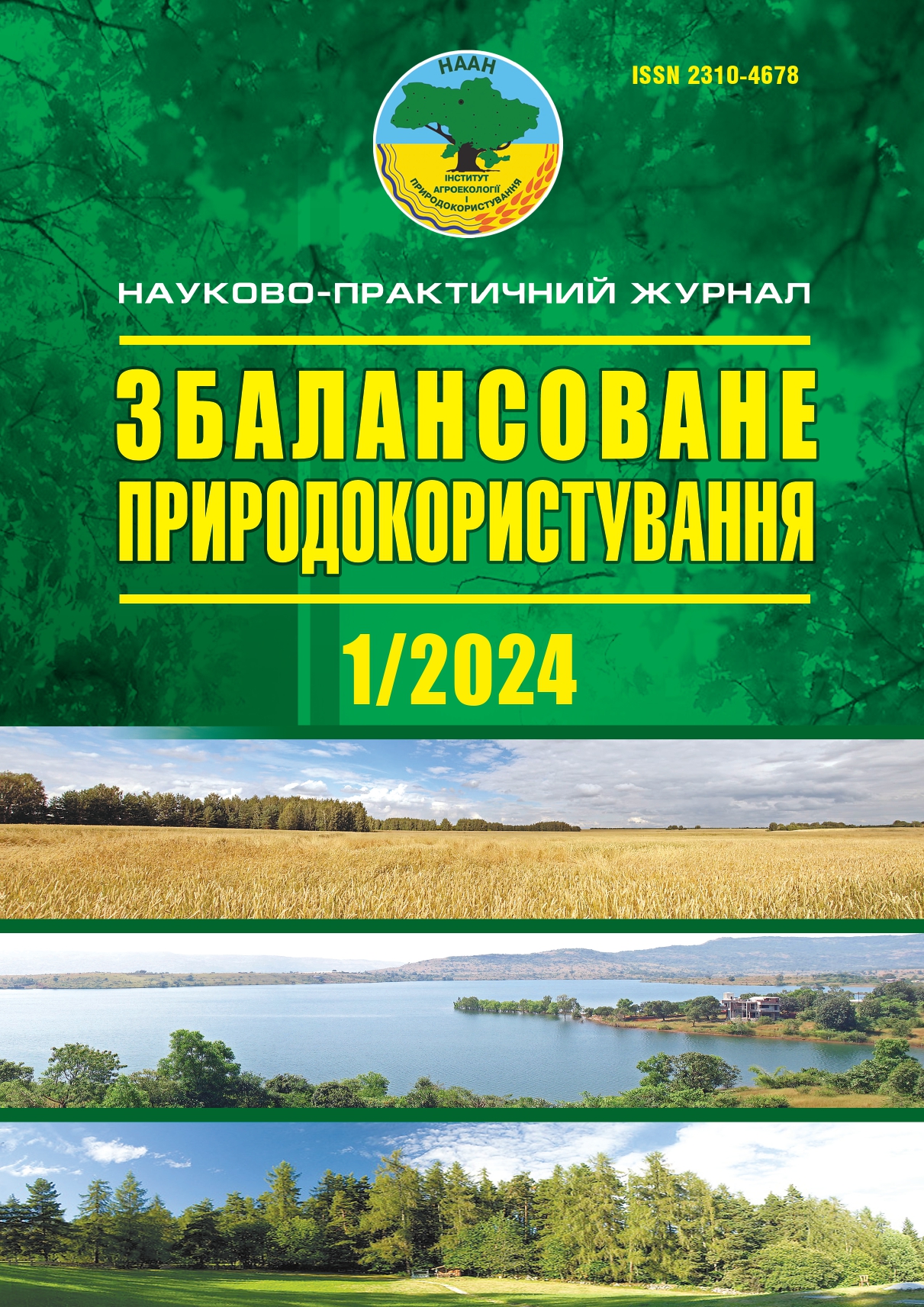Іригаційний потенціал малих і середніх річок басейну Причорномор’я у межах Одеської області
DOI:
https://doi.org/10.33730/2310-4678.1.2024.302626Ключові слова:
зрошення, стік річок, якість вод, найгірший за водністю, ризик погіршенняАнотація
Метою роботи є визначення можливості використання вод річок Причорномор’я для покриття потреб зрошувального землеробства в цьому регіоні. У статті висвітлено актуальність розглянутої проблеми та обґрунтування вибору напряму дослідження, обрані показники іригаційної оцінки якості вод для розв’язання поставленого завдання. До іригаційного потенціалу річок Причорномор’я в межах Одеській області віднесено стік річок за теплий період року, середнього за водністю та маловодних років із забезпеченістю 75% і 95% за відрахуванням екологічного стоку (75% стоку в найгірший за водністю місяць року з 95% забезпеченістю). В іригаційний потенціал не входять води, непридатні для зрошення за мінералізацією. Використання середніх значень показників при оцінці якості іригаційних вод призводить до того, що впродовж теплого періоду року з великою імовірністю можливі поливи некондиційною водою. У зв’язку із цим у статті запропоновано оцінку ризику погіршення якості вод за окремими показниками. При виконанні роботи встановлено, що води частини річок басейну Причорномор’я мають мінералізацію від 1 до 3 г/дм3 і належать до класу 3 (підвищено небезпечні для рослин), друга частина — більше 3 г/дм3 (непридатні для зрошування води). Середній багаторічний потенціал річкових вод басейну протягом теплого періоду року складає 56,3 млн м3/ТПР. Це дуже малий об’єм вод. Його вистачить для поливу лише 16,1 тис. га земель за умови хімічної меліорації цих вод і розбавлення водою з малою мінералізацією. Отже, зрошення сільгоспугідь у басейні річок Причорномор’я можливе лише за використання вод Дунаю і Дністра.
Посилання
Klimenko, V., Prasul, Yu., & Bashirov, I. (2019). Terytorialni osoblyvosti vodno-resursnoho potentsialu Kyivskoi oblasti [Territorial features of the water resource potential of the Kyiv region]. The problems of continuous geographical education and cartography, 30, 61–69 [in Ukrainian].
Rudenko, V.P., Vatseba, V.Ya., & Solovei, T.V. (2001). Pryrodno-resursnyi potentsial pryrodnykh oblastei Ukrainy [Natural resource potential of natural regions of Ukraine]. Chernivtsi: Ruta [in Ukrainian].
Zavadskykh, H.M. Pryrodno-resursnyi potentsial Ukrainy [Natural resource potential of Ukraine]. Rehionalna ekonomika: еlektronnyi posibnyk — Regional economics: electronic guide. URL: https://elib.tsatu.edu.ua/dep/feb/ptbd_2/page8.html [in Ukrainian].
Vyshnevskyi, V.I. (2000). Richky i vodoimy Ukrainy. Stan i vykorystannia [Rivers and reservoirs of Ukraine. Condition and use]. Kyiv: Vipol [in Ukrainian].
Dorohuntsov, S.I., Khvesyk, M.A., & Holovynskyi, I.A. (2002). Vodne hospodarstvo Ukrainy: suchasnyi stan ta perspektyvy rozvytku [Water management of Ukraine: current state and development prospects]. Kyiv: CSPF of NAS of Ukrainy [in Ukrainian].
Khilchevskyi, V.K., & Hreben, V.V. (Eds.). (2014). Vodnyi fond Ukrainy: Shtuchni vodoimy — vodoskhovyshcha i stavky [The Water Fund of Ukraine: Artificial reservoirs — reservoirs and ponds]. Kyiv: Interpres [in Ukrainian].
Khoriev, V.M. (Ed.). (2001). Vodnyi fond Ukrainy [Water Fund of Ukraine]. Kyiv: Nika-Tsentr [in Ukrainian].
Yatsyk, A.V. (Ed.). (2000). Vodne hospodarstvo Ukrainy [Water management of Ukraine]. Kyiv: Heneza [in Ukrainian].
Yurasov, S.M., Kuzmina, V.A., & Karaulov, V.D. (2021). Irrigative Assessment of Sasyk Water Quality. Journal Environmental problems, 6, 2, 69–77 [in English].
Concerning the quality required of surface water intended for the abstraction of drinking water in the Member States: Council Directive 75/440/EEC of 16 June 1975. (1975). The Council of the European Communities. URL: https://eur-lex.europa.eu/legal-content/EN/TXT/PDF/?uri=CELEX:31975L0440&from=en [in English].
Balachuk, V.Yu., Mokin, V.B., & Yashcholt, A.R. (2013). Otsiniuvannia ekolohichnykh ryzykiv pryrodnykh ekosystem, predstavlenykh informatsiinoiu modelliu z heometrychnoiu merezheiu [Assessment of environmental risks of natural ecosystems represented by an information model with a geometric network]. Naukovi pratsi VTU — Scientific works of VTU, 1–7 [in Ukrainian].
Davybida, L.I., & Podholov, V.M. (2019). Heoinformatsiina otsinka ryzyku zabrudnennia pidzemnykh vod Chernihivskoi oblasti [Geoinformation assessment of the risk of groundwater pollution in the Chernihiv region]. Ekolohichnyi monitorynh, prohnozuvannia ta otsinka stanu dovkillia — Ecological monitoring, forecasting and assessment of the state of the environment, 1 (19), 59–68 [in Ukrainian].
Mokiienko, A.V., Kovalchuk, L.I., & Krisilov, A.D. (2017). Yakist vody poverkhnevykh vodoim yak faktor ryzyku dlia zdorovia naselennia: matematychna model [Water quality of surface reservoirs as a risk factor for public health: a mathematical model]. Visnyk NAN Ukrainy: Statti ta ohliady — Bulletin of the National Academy of Sciences of Ukraine: Articles and reviews, 10, 42–52 [in Ukrainian].
Alekseieva, A.O. (2020). Ekolohichna otsinka sposobiv zroshennia silskohospodarskykh kultur [Ecological evaluation of methods of irrigation of agricultural crops]. Ekolohichni nauky — Environmental sciences, 1 (28), 130–134 [in Ukrainian].
##submission.downloads##
Опубліковано
Номер
Розділ
Ліцензія
- Автори залишають за собою право на авторство своєї роботи та передають журналу право першої публікації цієї роботи на умовах ліцензії Creative Commons Attribution License, котра дозволяє іншим особам вільно розповсюджувати опубліковану роботу з обов'язковим посиланням на авторів оригінальної роботи та першу публікацію роботи у цьому журналі.
- Автори мають право укладати самостійні додаткові угоди щодо неексклюзивного розповсюдження роботи у тому вигляді, в якому вона була опублікована цим журналом (наприклад, розміщувати роботу в електронному сховищі установи або публікувати у складі монографії), за умови збереження посилання на першу публікацію роботи у цьому журналі.
- Політика журналу дозволяє і заохочує розміщення авторами в мережі Інтернет (наприклад, у сховищах установ або на особистих веб-сайтах) рукопису роботи, як до подання цього рукопису до редакції, так і під час його редакційного опрацювання, оскільки це сприяє виникненню продуктивної наукової дискусії та позитивно позначається на оперативності та динаміці цитування опублікованої роботи (див. The Effect of Open Access).


